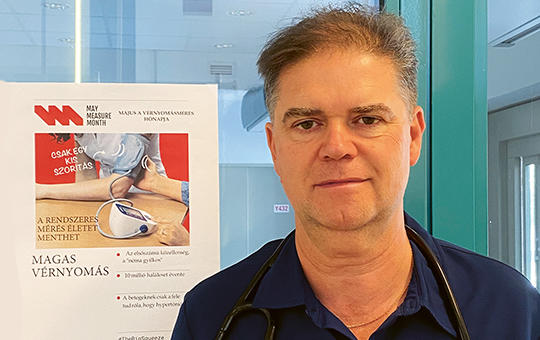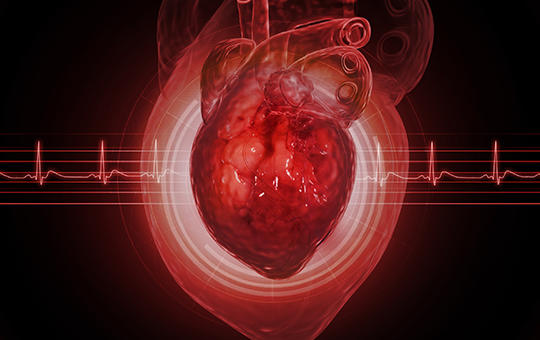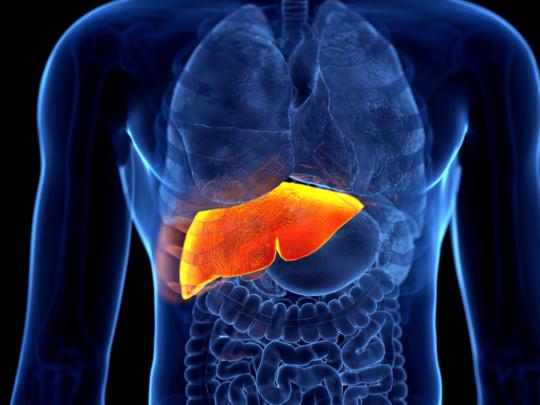The eLitMed.hu medical portal uses computer cookies for convenient operation. Detailed information can be found in the Cookie-policy.
Lege Artis Medicinae - 2024;34(1-2)
Content
[Pharmacotherapy of chronic heart failure with reduced ejection fraction: vericiguat, the developing 5th pillar? ]
[The incidence and prevalence of chronic heart failure (HF) is increasing worldwide, its morbidity and mortality remains high, and its adequate management is of paramount importance. Currently the treatment of heart failure with reduced ejection fraction (HFrEF) relies on four pillars: ACE inhibitors/ARNI, β-blockers, MRAs, and as the newest class, SGLT-2 inhibitors, all of which have been proven to reduce mortality and morbidity in HFrEF patients. A relatively new therapeutic option for the pharmacotherapy of HFrEF is vericiguat a soluble guanylate cyclase stimulator, which modifies the NO-sGC-cGMP signaling pathway impaired in heart failure patients. Vericiguat activates the sGC enzyme independently of the presence of nitric oxide, resulting in elevated intracellular cGMP levels, which can improve endothelial, myocardial, and vascular functions alike. Safety and efficacy of vericiguat were confirmed in the VICTORIA trial. Vericiguat significantly reduced the composite endpoint of HF hospitalization and cardiovascular death compared to placebo in chronic HF patients recently hospitalized for HF or requiring parenteral diuretic therapy with an ejection fraction worse than 45%. The relative risk reduction was 10%, and the absolute risk reduction was 4.2% in the vericiguat group. Due to the positive outcomes observed in the VICTORIA trial, vericiguat was included as a new pharmacotherapeutic option in the 2021 ESC Heart Failure guidelines. The current recommendation suggests the use of vericiguat with a level IIb evidence for HFrEF patients who recently required medical care due to heart failure progression despite optimal pharmacotherapy. ]
[Recent results of lifestyle and drug-induced body-weight reduction ]
[Among the specific weight loss diets, there is no convincing fundamental difference in their short-term effects. There is no magic bullet since weight regain is common with all methods in the long term (the greater the reduction the greater the regain). Thus for the majority of patients in need none of them has any significant outcome (–10% per 2 years). Only the safety of some dietary methods has been clarified so far. Although the Mediterranean diet is generally accepted (in a broader context, the Smart Plate developed for domestic conditions by the National Association of Hungarian Dietitians too), however intermittent fasting and e.g. the time-restricted eating may also have some advantages. It would be reasonable to attribute more importance to the patient’s preference during the (repeated) dietetic consultations (the question is who could mediate it authentically?) Nutritional therapy requires essentially (or should require) medical treatment of excess weight, which would also support growing-up of obesitology. In metabolic medicine, entero-hormones, primarily glucagon-like peptide-1 receptor agonists (GLP-1 RA), opened a new chapter in the history of medicine. Newer, more effective forms of this drug family make at least 10% weight loss attainable to most of those in need, and as long as their use continues its cardiovascular benefits have also been proven.]
[Reno- and cardioprotective effects of sodium-glucose cotransporter 2 inhibitors beyond treating diabetes mellitus ]
[SGLT2-inhibitors, originally used as antidiabetics, improved unexpectedly the outcome of cardiac diseases (mainly heart failure) and nearly halved the risk of renal events of diabetic patients. More recently, administering these drugs decreased significantly the morbidity and mortality in primary renal endpoint studies and among patients with heart failure – in diabetic and non-diabetic patients respectively. Concerning these recent outcomes and according to international and domestic guidelines, SGLT-2 inhibitors are considered as first line medications in both chronic kidney disease and the whole spectrum of chronic heart failure, and they should be initiated as early as possible in these conditions. Since the beginning of 2024, these drugs which changed significantly the outcome of these diseases can be prescribed with greater support of Hungarian public financing not only for type 2 diabetic patients but non-diabetics too with chronic kidney diseases and heart failure with reduced ejection fraction. ]
[Cardiovascular risk of diabetic female patients ]
[This study reviews the cardiovascular risk of women with type 1, gestational, and type 2 diabetes.
Research data published so far in this topic have confirmed a number of cardiovascular risk factors, which may cause differences in risk profile between female and male diabetic patients. As soon as recognizing diabetes, we have to concern the patients’ cardioprotective diet, assessment of their cardiovascular risk factors and aiming their therapeutic target values. ]
[Gynaecological hormone therapy and cardiovascular risk. Part 2: menopausal hormone therapy ]
[Concerning cardiovascular (CV) risk, beside hormonal contraception, menopausal hormone therapy (MHT) has a pre-eminent clinical significance. If women start MHT younger than 60 years of age, or within 10 years after their menopausal transition, the risk of coronary diseases and mortality too decreases. Conventional oral MHT slightly increases the risk of venous thromboembolism (VTE) and stroke, while transdermal admission does not it. MHT initiated in women above 60, raise the risk of cardiovascular (CV) diseases, thus it is useful to start MHT at the onset of menopause syndrome signs (primarily hot flashes), preferably at a younger age. Preventing serious late complications to start and continue MHT at least until natural menopause is essential in premature ovarian insufficiency and early menopause. Below, we summarize the CV implications of MHT and its alternative treatment options.]
[Liver diseases in the general practitioner’s practice – when should we think about it?]
[Hepatology has developed explosively in the last decades. Etiology and pathomechanism of a number of diseases became known, thus effective treatments for the majority of liver conditions are recently available. This development increases the responsibility of all practitioners, since the doctors should realize more or less which treatment options are available for diseases outside of their specialties. In other words, recognizing exactly the etiological background is important, because it has therapeutic consequences in the patients’ majority. In this study, we review the symptoms and findings that should awake suspicion of liver pathology and summarize the prognosis and therapy of the most important liver diseases.]
[The place of rosuvastatin/acetylsalicylic acid fixed combination in the daily practice ]
[In Hungary, cardiovascular diseases are the leading cause of death; however, they have also a large share among preventable and treatable conditions. Statins and acetylsalicylic acid (ASA) play a prominent role in the secondary prevention of cardiovascular diseases. Their areas of application are wide, but at the same time, they are recommended for secondary prevention of many common cardiovascular diseases. Among acetylsalicylic acid and statin combinations, the ASA/rosuvastatin combination – if compared to other statins – reduced most significantly the risk of cardiovascular diseases. Other studies have highlighted the benefits of fixed drug combinations in cardiovascular risk reduction.
A new domestic fixed combination, containing that of ASA/rosuvastatin can claim a prominent position in the secondary prevention of cardiovascular diseases.]
1.
Clinical Neuroscience
Is there any difference in mortality rates of atrial fibrillation detected before or after ischemic stroke?2.
Clinical Neuroscience
Factors influencing the level of stigma in Parkinson’s disease in western Turkey3.
Clinical Neuroscience
Neuropathic pain and mood disorders in earthquake survivors with peripheral nerve injuries4.
Journal of Nursing Theory and Practice
[Correlations of Sarcopenia, Frailty, Falls and Social Isolation – A Literature Review in the Light of Swedish Statistics]5.
Clinical Neuroscience
[Comparison of pain intensity measurements among patients with low-back pain]1.
Clinical Neuroscience Proceedings
[A Magyar Stroke Társaság XVIII. Kongresszusa és a Magyar Neuroszonológiai Társaság XV. Konferenciája. Absztraktfüzet]2.
3.
Journal of Nursing Theory and Practice
[A selection of the entries submitted to the literary contest "Honorable mission: the joys and challenges of our profession" ]4.
Journal of Nursing Theory and Practice
[End of Life and Palliative Care of Newborns in the Nursing Context]5.
Journal of Nursing Theory and Practice
[Aspects of Occupational Health Nursing for Incurable Patients ]



















